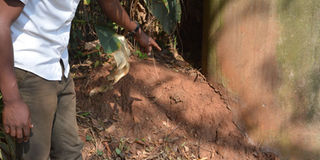The right soil sample for your garden

Sub soil is not recommended for planting.
What you need to know:
Having healthy plants starts with the choice of soil. We share the right kind of soil for your plants, and how to care and support poor soils.
A well-planned garden is easier to take care of. It saves time and is more appealing than an unplanned garden. Having the best garden starts from choosing the best soil for your plants as good soil will determine the results in the garden.
To have the best plants with flourishing flowers, you will have to check the kind of soil you are to give your plants and enhance them where necessary for them to grow up healthy. Having good soil in your garden is better than having the best weather or climate.
Lawrence Lwanyaga, of CIDI (Training Centre for Gardening and Landscaping in Muyenga), explains there are three types of soil that is the loam soil, clay soil and sand soil. Each of these are made of different components that make them different.
Loam soil
Loam soil is a mixture of three different particles of clay, sand and silt. Lwanyaga notes that this is the best type of soil for all plants. It allows water to penetrate through the soil and gives room for the soil animals to thrive.
This type of creatures, such as snails, are very important especially for making humus which feeds the plants. Loam soil can be used in both dry and wet lands.
Clay soil
Clay soil has an imbalance of the sand and silt components. Though its also used in planting, it is less preferred as it does not allow the percolation of water.
Lwanyanga notes that this type of soil cannot be used in desert or areas with a lot of sun. This is best for aquatic plants that need a lot water to survive but will not work for other plants. “Instead of the water penetrating the plant, it will log in there hence generating heat and burning up the plant,” he notes.
Sandy soil
Sandy soil is also good for plants. The difference between sand soil and loam soil is that sand soil has big particles and therefore does not hold water for long like loam soil does. It is used for planting flowers as well but will need to be supported with manure.
How to support poor soils
Add manure
Sharon Amoding, a landscaper, notes that when the soil is not good enough, you can consider adding manure. You can have a mixture of animal waste for instance, cow dung, chicken waste or decaying leaves.
“This helps give crops natural growth and restores its value. These should be left to rot in a certain place before being placed in the containers,” she adds.
Potting
Mixed soil with manure can work best in a vessel or pot and plants placed in there because some plants could erode if left on an open land.
Add fertilisers
Amoding says adding fertilisers is another way of enriching poor soil.
These should not be added in large quantities because unlike natural manure, too much of these could negatively affect the garden.
However, there are certain plants where type of soil does not matter. mint. These will blossom in all types of soil and with little or no supervision.
Boniface Wanja, a landscaper, says areas in Mukono have the best soil for plants. Amoding says areas around Kasangati also have good soil.
In Kampala, one can also buy soil from landscaping and plant centres in Muyenga and other areas.
How to take care of your soil
Boniface Wanja, a landscaper, notes that to prevent your soil from losing fertility, you should do the following.
Avoid dumping polythene paper
Wanja notes that polyethene bags bar water from entering the soil and also limit aeration. He says you should avoid dumping polyethene papers anyhow for the best soil.
Water the soil
Dryness also contributes to poor soil as dryness kills the important bacterial in the soil leaving it prone to destruction. Watering the plants and in turn the soil will help you protect it from damage.
Plant legumes before plants
He adds that legumes contribute towards good soil production as they add to the humus in the soil. This will in turn help increase the fertility in the soil.
Sharon Amoding, a landscaper, notes that you should have your soil tested by agriculture experts so that you know the type of soil you have and get advice on how to enhance it.




